Occupying the western portion of Central Greece, the prefecture of Etoloakarnania combines the beauty of both the sea and the mountains. The capital of the prefecture is Messolonghi (244 km from Athens), the sacred city of Greece. The heroic exodus of the “Free Besieged” was a bright spot in our modern history as well as a source of inspiration for poets such as Solomos and Byron as well as for other artists.
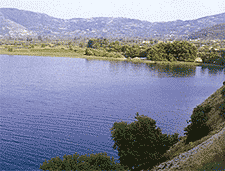 The city was founded in the 16th century on three islets at the mouth of the Acheloos and Evinos Rivers, which were later united by silting to form three scenic lagoons.
The city was founded in the 16th century on three islets at the mouth of the Acheloos and Evinos Rivers, which were later united by silting to form three scenic lagoons.
On entering the city you will see the Exodus gate and the “Garden of the Heroes”. In the central squaqre, the Town Hall houses the picture gallery.
If you’re a history buff, then you’ll want to visit Ancient Kalidon, Ancient Pleuron, “the castle of Kira Rhini”, as the locals call it, and the Windmill, a Revolutionary monument.
About 6 km. north of town, in a landscape filled with plane trees and running water, stands the historic monastery of Aghios Simeon (17th c.). This is where 1,800 of the besieged sought refuge and were saved. Since that time, every year on Whitmonday, a lively folk festival takes place.
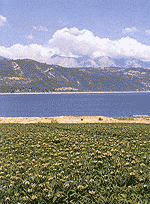 The small island of Etoliko lies 13 km. northwest of Messolongi and is connected to the mainland by an arched stone bridge. From a distance its view is fascinating to the eye of the visitor.
The small island of Etoliko lies 13 km. northwest of Messolongi and is connected to the mainland by an arched stone bridge. From a distance its view is fascinating to the eye of the visitor.
Some 50 km northwest of Messolonghi the summer resort of Astakos, a picturesque market town, overlooks the gulf of the same name. Its extended unspoilt beaches with fine white sand and the sea of every shade of blue at Aghios Yorgis, Asprogiali and Vela make the area perfect for quiet, carefree holidays.
Boats leave Astakos daily for Cephalonia and Ithaca. Another sight worth seeing in the region is the monastery of the Profitis Ilias (15th c.) near the village bearing the name of Karaiskakis, where the illustrious Revolutionary used to have his headquarters.
Still following the coast, the road leads to Mitikas, a village built at the end of the gulf of the same name. From here you can find a little boat to take you across to Kalamos and Kastos, small islands with marvellous beaches. Just a hop from Mitikas are the interesing ruins of the ancient city of Alizea, and there is a very pretty beach at Paliomagaza. A few kilometers north of Mitikas you come to Paleros, a fishing village with another lovely beach.
After Paleros the coastal road that winds up at Aktion loops inland before reaching Vonitsa, a pretty seaside and very green town at the entrance to the Amvrakikos gulf, built atop the foundations of ancient Anaktorion. At “Aghios Petros” there are ruins of ancient temples and walls, while on the hill above a ruined medieval castle stands sentinel near the chapel of Divine Wisdom (12th c.) fashioned like a Byzantine fortress.
Continuing west, 15 km. on the road one comes to Aktion, renowned in history as the site of the great naval battle between Octavian and Marc Antony. Here lies the famous “Channel of Cleopatra”, the area through which the fleet belonging to the celebrated queen of Egypt was anchored prior to its defeat at Aktion. Here can also be seen the ruins of a Venetian citadel and an archaeological site. East of Vonitsa, the road passes near Thirio, which has a fine archaeological museum, before reaching Amfilohia.
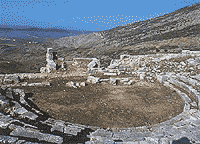 The buildings of Amfilohia cover the slopes of two hills, providing a panoramic view towards the end of the gulf towards Arta. Amfilohian Argos lies 10 km. further north.
The buildings of Amfilohia cover the slopes of two hills, providing a panoramic view towards the end of the gulf towards Arta. Amfilohian Argos lies 10 km. further north.
Nearby beaches for bathing and fishing exist at Sparto, Ai Yorgi and Bouka, where the old monastery of Aghios Nikolaos is located. Further north, at Menidi you can feast on all manner of seafood at its waterfront ouzeri and tavernas.
South of Amfilohia, on the national road towards Agrinio, we suggest you make a little detour and go to Katouna, on the shores of lake Amvrakia to admire its fabulous view.
Agrinio (35 km. north of Messolonghi) is an important tobacco – producing center with good facilities for tourists. The archaeological museum, the Papastratios Municipal Library, and the grove of Aghios Christoforos on the hillside with a panoramic view, are some of the sights worth seeing in town.
Other recommended stops include a visit to Angelokastro with its Byzantine monastery of the Pantocrator; the ruins of a 12th century Byzantine fortress at Melagi Hora (4 km NW); the Klissoura gorge with the monastery of Aghia Eleoussa; and the enchanting landscape around the Aheloos dam. East of Agrinio, along lake Trihonida, you come to the vlllage of Thermo, near the ruins of Ancient Thermo, where there is an interesting museum.
On the coast road that unites Fokida with Etoloakarnania you arrive at Nafpaktos, the prefecture’s third largest town, famous for the battle that took place off its shores in 1571. This market town with its atractive Venetian castle and circular walled harbour will delight even the most demanding visitors. The well-preserved citadel, with its series of ramparts winding up to the top of the hill, is one of the most beautiful in Greece.
All along this coast the sea is crystal clear. At Psani and Gribava, where the plane trees grow down to the water’s edge, the scenery is idyllic, while at Hiliadou (11 km. to the east) the shore is just right for swimming.
The mountains near the town are the most thickly wooded with spruce and firs in all Greece; of a rare beauty, they are worth visiting in summer and winter alike. Platanas, known for its forest which contains dozens of species of trees, Arahova, Perkos, Dorvitsia, Simos, Ano Hora, Terpsithea, Elatou, Hrissovo and Ambelakiotissa – tiny villages in the woods 700 to 1000 meters above sea level – will beguile you with their primitive beauty.
 The city was founded in the 16th century on three islets at the mouth of the Acheloos and Evinos Rivers, which were later united by silting to form three scenic lagoons.
The city was founded in the 16th century on three islets at the mouth of the Acheloos and Evinos Rivers, which were later united by silting to form three scenic lagoons. On entering the city you will see the Exodus gate and the “Garden of the Heroes”. In the central squaqre, the Town Hall houses the picture gallery.
If you’re a history buff, then you’ll want to visit Ancient Kalidon, Ancient Pleuron, “the castle of Kira Rhini”, as the locals call it, and the Windmill, a Revolutionary monument.
About 6 km. north of town, in a landscape filled with plane trees and running water, stands the historic monastery of Aghios Simeon (17th c.). This is where 1,800 of the besieged sought refuge and were saved. Since that time, every year on Whitmonday, a lively folk festival takes place.
 The small island of Etoliko lies 13 km. northwest of Messolongi and is connected to the mainland by an arched stone bridge. From a distance its view is fascinating to the eye of the visitor.
The small island of Etoliko lies 13 km. northwest of Messolongi and is connected to the mainland by an arched stone bridge. From a distance its view is fascinating to the eye of the visitor.Some 50 km northwest of Messolonghi the summer resort of Astakos, a picturesque market town, overlooks the gulf of the same name. Its extended unspoilt beaches with fine white sand and the sea of every shade of blue at Aghios Yorgis, Asprogiali and Vela make the area perfect for quiet, carefree holidays.
Boats leave Astakos daily for Cephalonia and Ithaca. Another sight worth seeing in the region is the monastery of the Profitis Ilias (15th c.) near the village bearing the name of Karaiskakis, where the illustrious Revolutionary used to have his headquarters.
Still following the coast, the road leads to Mitikas, a village built at the end of the gulf of the same name. From here you can find a little boat to take you across to Kalamos and Kastos, small islands with marvellous beaches. Just a hop from Mitikas are the interesing ruins of the ancient city of Alizea, and there is a very pretty beach at Paliomagaza. A few kilometers north of Mitikas you come to Paleros, a fishing village with another lovely beach.
After Paleros the coastal road that winds up at Aktion loops inland before reaching Vonitsa, a pretty seaside and very green town at the entrance to the Amvrakikos gulf, built atop the foundations of ancient Anaktorion. At “Aghios Petros” there are ruins of ancient temples and walls, while on the hill above a ruined medieval castle stands sentinel near the chapel of Divine Wisdom (12th c.) fashioned like a Byzantine fortress.
Continuing west, 15 km. on the road one comes to Aktion, renowned in history as the site of the great naval battle between Octavian and Marc Antony. Here lies the famous “Channel of Cleopatra”, the area through which the fleet belonging to the celebrated queen of Egypt was anchored prior to its defeat at Aktion. Here can also be seen the ruins of a Venetian citadel and an archaeological site. East of Vonitsa, the road passes near Thirio, which has a fine archaeological museum, before reaching Amfilohia.
 The buildings of Amfilohia cover the slopes of two hills, providing a panoramic view towards the end of the gulf towards Arta. Amfilohian Argos lies 10 km. further north.
The buildings of Amfilohia cover the slopes of two hills, providing a panoramic view towards the end of the gulf towards Arta. Amfilohian Argos lies 10 km. further north. Nearby beaches for bathing and fishing exist at Sparto, Ai Yorgi and Bouka, where the old monastery of Aghios Nikolaos is located. Further north, at Menidi you can feast on all manner of seafood at its waterfront ouzeri and tavernas.
South of Amfilohia, on the national road towards Agrinio, we suggest you make a little detour and go to Katouna, on the shores of lake Amvrakia to admire its fabulous view.
Agrinio (35 km. north of Messolonghi) is an important tobacco – producing center with good facilities for tourists. The archaeological museum, the Papastratios Municipal Library, and the grove of Aghios Christoforos on the hillside with a panoramic view, are some of the sights worth seeing in town.
Other recommended stops include a visit to Angelokastro with its Byzantine monastery of the Pantocrator; the ruins of a 12th century Byzantine fortress at Melagi Hora (4 km NW); the Klissoura gorge with the monastery of Aghia Eleoussa; and the enchanting landscape around the Aheloos dam. East of Agrinio, along lake Trihonida, you come to the vlllage of Thermo, near the ruins of Ancient Thermo, where there is an interesting museum.
On the coast road that unites Fokida with Etoloakarnania you arrive at Nafpaktos, the prefecture’s third largest town, famous for the battle that took place off its shores in 1571. This market town with its atractive Venetian castle and circular walled harbour will delight even the most demanding visitors. The well-preserved citadel, with its series of ramparts winding up to the top of the hill, is one of the most beautiful in Greece.
All along this coast the sea is crystal clear. At Psani and Gribava, where the plane trees grow down to the water’s edge, the scenery is idyllic, while at Hiliadou (11 km. to the east) the shore is just right for swimming.
The mountains near the town are the most thickly wooded with spruce and firs in all Greece; of a rare beauty, they are worth visiting in summer and winter alike. Platanas, known for its forest which contains dozens of species of trees, Arahova, Perkos, Dorvitsia, Simos, Ano Hora, Terpsithea, Elatou, Hrissovo and Ambelakiotissa – tiny villages in the woods 700 to 1000 meters above sea level – will beguile you with their primitive beauty.
Messolonghi
Messolongi (or Messolonghi), with ca 15,000 inhab., is the capital of the district (nome) of Aitoloakarnania, and the seat of a bishop. The town is, by repute, more familiar to the English-speaking world than many others in Greece of greater importance, for here Lord Byron (born 1788) died of fever on 19 April 1824, after ten months of incessant activity in the cause of Greek independence. Mesolongi, now by-passed by the main highway, is situated on the E shore of a vast lagoon (Limnothalassa) partly given over to fish hatcheries and the haunt of many water-birds. 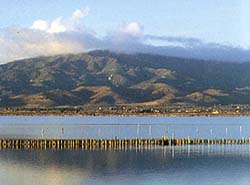 This has always been too shallow to allow the approach of vessels of any size, and a long causeway extends S to deep water at Tourlidha. The local sailing boats have affinities with the Egyptian felucca and the nets are unusual. Drainage and reclamation work is hastening the disappearance of the fishing community and their characteristic reed huts built on piles. In the local cafes the 'mezes' are varied and good. Mesolongi was the W centre of resistance against the Turks in the War of Independence, and had to endure three sieges. In 1822 it was defended by Mavrogordato against a force of 10,000 led by Omer Vrioni and Reshid Pasha. In 1823 its commander was the Suliot, Markos Botsaris. In January 1824 Lord Byron came to Mesolongi and inspired the defenders with his enthusiasm; he died the following April before the beginning of the final siege. In April 1825 Reshid Pasha appeared before the town with 15,000 troops. The defenders numbered only 5000. Hampered by furious sorties and by a lack of supplies Reshid Pasha could make no headway for six months. Then Ibrahim Pasha, with 10,000 Egyptians, advanced to his aid from the Peloponnese. After fluctuating struggles for the islands in the lagoon, the enemy closed round the devoted town. At the end of their resources after 12 months of siege, almost the whole population determined to break out. Their attempt (the 'Exodos') was made on the night of 22/23 April 1826. Though they managed to get clear of the town, they were frustrated by the treachery of a Bulgarian deserter, who had forewarned the besiegers.
This has always been too shallow to allow the approach of vessels of any size, and a long causeway extends S to deep water at Tourlidha. The local sailing boats have affinities with the Egyptian felucca and the nets are unusual. Drainage and reclamation work is hastening the disappearance of the fishing community and their characteristic reed huts built on piles. In the local cafes the 'mezes' are varied and good. Mesolongi was the W centre of resistance against the Turks in the War of Independence, and had to endure three sieges. In 1822 it was defended by Mavrogordato against a force of 10,000 led by Omer Vrioni and Reshid Pasha. In 1823 its commander was the Suliot, Markos Botsaris. In January 1824 Lord Byron came to Mesolongi and inspired the defenders with his enthusiasm; he died the following April before the beginning of the final siege. In April 1825 Reshid Pasha appeared before the town with 15,000 troops. The defenders numbered only 5000. Hampered by furious sorties and by a lack of supplies Reshid Pasha could make no headway for six months. Then Ibrahim Pasha, with 10,000 Egyptians, advanced to his aid from the Peloponnese. After fluctuating struggles for the islands in the lagoon, the enemy closed round the devoted town. At the end of their resources after 12 months of siege, almost the whole population determined to break out. Their attempt (the 'Exodos') was made on the night of 22/23 April 1826. Though they managed to get clear of the town, they were frustrated by the treachery of a Bulgarian deserter, who had forewarned the besiegers.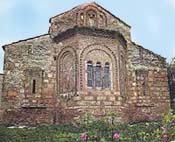 The fugitives, imagining themselves safe, were ambushed by 1000 Albanians on the slopes of Mt Zygos. Out of the 9000 who left Mesolongi, soldiers and civilians, only 1800 made good their escape to Amphissa. Meanwhile those who had stayed behind fired their magazines, overwhelming themselves and their enemies in a common destruction. In 1828 the Turks surrendered Mesolongi without firing a shot.
The fugitives, imagining themselves safe, were ambushed by 1000 Albanians on the slopes of Mt Zygos. Out of the 9000 who left Mesolongi, soldiers and civilians, only 1800 made good their escape to Amphissa. Meanwhile those who had stayed behind fired their magazines, overwhelming themselves and their enemies in a common destruction. In 1828 the Turks surrendered Mesolongi without firing a shot.
The town is entered through the Venetian walls by the 'Gate of the Sortie,' rebuilt by King Otho to protect the hastily repaired earthen rampart through which the exodos was made. Within the gate (right) is a pleasant garden with the Heroon commemorating the heroes of the town's three sieges. A large central tumulus contains the bodies of unnamed defenders; to the right is the tomb of Botsaris, and, between the two a statue of Byron erected in 1881, beneath which is the poet's heart. The centre of the town is the Plateia (Square) Botsari, where the Dhimarkhion houses the Museum of the Revolution, with Byron relics and several dramatic pictures of the war. Odhos Trikoupis leads W and at its end Odhos Levidou brings us to a small square where a Memorial Garden occupies the site of the house in which Byron died: the house was destroyed in the Second World War. Continuing round a school we reach the causeway, with a bust of the poet Kostis Palamas and the reconstructed base of the historic Windmill blown up by Christos Kapsalis on 11 April 1826.
 This has always been too shallow to allow the approach of vessels of any size, and a long causeway extends S to deep water at Tourlidha. The local sailing boats have affinities with the Egyptian felucca and the nets are unusual. Drainage and reclamation work is hastening the disappearance of the fishing community and their characteristic reed huts built on piles. In the local cafes the 'mezes' are varied and good. Mesolongi was the W centre of resistance against the Turks in the War of Independence, and had to endure three sieges. In 1822 it was defended by Mavrogordato against a force of 10,000 led by Omer Vrioni and Reshid Pasha. In 1823 its commander was the Suliot, Markos Botsaris. In January 1824 Lord Byron came to Mesolongi and inspired the defenders with his enthusiasm; he died the following April before the beginning of the final siege. In April 1825 Reshid Pasha appeared before the town with 15,000 troops. The defenders numbered only 5000. Hampered by furious sorties and by a lack of supplies Reshid Pasha could make no headway for six months. Then Ibrahim Pasha, with 10,000 Egyptians, advanced to his aid from the Peloponnese. After fluctuating struggles for the islands in the lagoon, the enemy closed round the devoted town. At the end of their resources after 12 months of siege, almost the whole population determined to break out. Their attempt (the 'Exodos') was made on the night of 22/23 April 1826. Though they managed to get clear of the town, they were frustrated by the treachery of a Bulgarian deserter, who had forewarned the besiegers.
This has always been too shallow to allow the approach of vessels of any size, and a long causeway extends S to deep water at Tourlidha. The local sailing boats have affinities with the Egyptian felucca and the nets are unusual. Drainage and reclamation work is hastening the disappearance of the fishing community and their characteristic reed huts built on piles. In the local cafes the 'mezes' are varied and good. Mesolongi was the W centre of resistance against the Turks in the War of Independence, and had to endure three sieges. In 1822 it was defended by Mavrogordato against a force of 10,000 led by Omer Vrioni and Reshid Pasha. In 1823 its commander was the Suliot, Markos Botsaris. In January 1824 Lord Byron came to Mesolongi and inspired the defenders with his enthusiasm; he died the following April before the beginning of the final siege. In April 1825 Reshid Pasha appeared before the town with 15,000 troops. The defenders numbered only 5000. Hampered by furious sorties and by a lack of supplies Reshid Pasha could make no headway for six months. Then Ibrahim Pasha, with 10,000 Egyptians, advanced to his aid from the Peloponnese. After fluctuating struggles for the islands in the lagoon, the enemy closed round the devoted town. At the end of their resources after 12 months of siege, almost the whole population determined to break out. Their attempt (the 'Exodos') was made on the night of 22/23 April 1826. Though they managed to get clear of the town, they were frustrated by the treachery of a Bulgarian deserter, who had forewarned the besiegers. The fugitives, imagining themselves safe, were ambushed by 1000 Albanians on the slopes of Mt Zygos. Out of the 9000 who left Mesolongi, soldiers and civilians, only 1800 made good their escape to Amphissa. Meanwhile those who had stayed behind fired their magazines, overwhelming themselves and their enemies in a common destruction. In 1828 the Turks surrendered Mesolongi without firing a shot.
The fugitives, imagining themselves safe, were ambushed by 1000 Albanians on the slopes of Mt Zygos. Out of the 9000 who left Mesolongi, soldiers and civilians, only 1800 made good their escape to Amphissa. Meanwhile those who had stayed behind fired their magazines, overwhelming themselves and their enemies in a common destruction. In 1828 the Turks surrendered Mesolongi without firing a shot.The town is entered through the Venetian walls by the 'Gate of the Sortie,' rebuilt by King Otho to protect the hastily repaired earthen rampart through which the exodos was made. Within the gate (right) is a pleasant garden with the Heroon commemorating the heroes of the town's three sieges. A large central tumulus contains the bodies of unnamed defenders; to the right is the tomb of Botsaris, and, between the two a statue of Byron erected in 1881, beneath which is the poet's heart. The centre of the town is the Plateia (Square) Botsari, where the Dhimarkhion houses the Museum of the Revolution, with Byron relics and several dramatic pictures of the war. Odhos Trikoupis leads W and at its end Odhos Levidou brings us to a small square where a Memorial Garden occupies the site of the house in which Byron died: the house was destroyed in the Second World War. Continuing round a school we reach the causeway, with a bust of the poet Kostis Palamas and the reconstructed base of the historic Windmill blown up by Christos Kapsalis on 11 April 1826.
Nafpaktos
Leaving Messolongi and passing beyond Andirrion the road runs a field's length from the sea, and for a brief period affords a long view right down the Gulf of Corinth. At 48km (30 miles) is Nafpaktos, a charming little town (ca 10,000 inhab.) with a good beach. 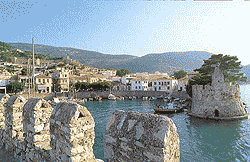 The picturesque, mainly Venetian, Castle, from which ramparts descend to enclose the little Harbour, recalls its medieval past when it was known in the West as Lepanto. The plateia (square), shaded by jacaranda trees, looks across the Gulf to Mt Panakhaikon. Here in 1571 the Turkish admiral fitted out before the decisive Battle of Lepanto, fought in fact off the Echinades. The allied fleet, under Don John of Austria, natural son of the Emp. Charles V, included contingents from Venice, Genoa, the Papal States, Spain, Sicily, and Naples.
The picturesque, mainly Venetian, Castle, from which ramparts descend to enclose the little Harbour, recalls its medieval past when it was known in the West as Lepanto. The plateia (square), shaded by jacaranda trees, looks across the Gulf to Mt Panakhaikon. Here in 1571 the Turkish admiral fitted out before the decisive Battle of Lepanto, fought in fact off the Echinades. The allied fleet, under Don John of Austria, natural son of the Emp. Charles V, included contingents from Venice, Genoa, the Papal States, Spain, Sicily, and Naples. 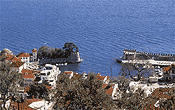 The Turks were assisted by the Bey of Alexandria and the Bey Algiers. The result was the overwhelming victory of Christendom and the Moslem sea-power suffered a blow from which it never recovered. The young Cervantes, creator of 'Don Quixote,' here lost the use of his left hand.
The Turks were assisted by the Bey of Alexandria and the Bey Algiers. The result was the overwhelming victory of Christendom and the Moslem sea-power suffered a blow from which it never recovered. The young Cervantes, creator of 'Don Quixote,' here lost the use of his left hand.
Ancient Nafpaktos, a town of the Ozolian Locrians, was taken in 455 by the Athenians. Here the established a colony of Messenians, who had been dispossessed by their Spartan conquerors. The place played an important part in the Peloponnesian War; it was successfully defended in 429 by Phormion and in 426 by Demosthenes against the Spartans, and became a base for the Sicilian expedition.
 The picturesque, mainly Venetian, Castle, from which ramparts descend to enclose the little Harbour, recalls its medieval past when it was known in the West as Lepanto. The plateia (square), shaded by jacaranda trees, looks across the Gulf to Mt Panakhaikon. Here in 1571 the Turkish admiral fitted out before the decisive Battle of Lepanto, fought in fact off the Echinades. The allied fleet, under Don John of Austria, natural son of the Emp. Charles V, included contingents from Venice, Genoa, the Papal States, Spain, Sicily, and Naples.
The picturesque, mainly Venetian, Castle, from which ramparts descend to enclose the little Harbour, recalls its medieval past when it was known in the West as Lepanto. The plateia (square), shaded by jacaranda trees, looks across the Gulf to Mt Panakhaikon. Here in 1571 the Turkish admiral fitted out before the decisive Battle of Lepanto, fought in fact off the Echinades. The allied fleet, under Don John of Austria, natural son of the Emp. Charles V, included contingents from Venice, Genoa, the Papal States, Spain, Sicily, and Naples.  The Turks were assisted by the Bey of Alexandria and the Bey Algiers. The result was the overwhelming victory of Christendom and the Moslem sea-power suffered a blow from which it never recovered. The young Cervantes, creator of 'Don Quixote,' here lost the use of his left hand.
The Turks were assisted by the Bey of Alexandria and the Bey Algiers. The result was the overwhelming victory of Christendom and the Moslem sea-power suffered a blow from which it never recovered. The young Cervantes, creator of 'Don Quixote,' here lost the use of his left hand. Ancient Nafpaktos, a town of the Ozolian Locrians, was taken in 455 by the Athenians. Here the established a colony of Messenians, who had been dispossessed by their Spartan conquerors. The place played an important part in the Peloponnesian War; it was successfully defended in 429 by Phormion and in 426 by Demosthenes against the Spartans, and became a base for the Sicilian expedition.

